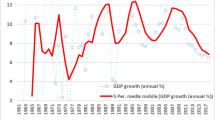Abstract
The recent slowdown in the Chinese economy is interpreted in two dimensions: a long-run, structural shift toward a moderation in China’s earlier high growth pace, and a short-run, mainly cyclical, adjustment to the earlier economic overheating. Main causes of the long-run shift are export deceleration, rising wage compensation, and higher energy import dependence, which all tend to lead Chinese investment growth and economic growth to scale down now and in the future, though possibly continuing on a fairly high pace around 8 %. On the other hand, the short-run one is a correction process, often complicated by external shocks. When policy over-reacts, the process of growth moderation—the long-run shift—would be possibly delayed. A more prudent macroeconomic policy should help China to carry through the task of growth adjustment. The process also bears significant implications for structural changes and rebalancing: convergence between consumption growth and investment growth; convergence between import and export growths; convergence in economic growth between China’s inland and coastal regions.








Similar content being viewed by others
Notes
The figures cited in the text and graphs, if unspecified, are all from the Chinese Statistical Bureau—China Statistical Abstract and China Statistical Yearbook, often latest versions.
References
Barsky RB, Kilian L (2004) Oil and the macro-economy since the 1970s. J Econ Perspect 18(4):115–134
Bloom DE, Canning D, Jaypee S (2003) The demographic dividend: a new perspective on the economic consequences of population change. Population matters, A RAND program of policy-relevant research communication, RAND
Cai F (2010) Demographic transition, demographic dividend, and Lewis turning point in China. Econ Res J (in Chinese) 4:4–13
Cai F, Wang D (2005) China’ s demographic transition: implications for growth. In: Garnaut R, Song L (eds) The China boom and its discontents. Asia Pacific Press, Canberra, Australia
Ding S, Knight J (2009) Can the augmented Solow Model Explain China’s remarkable economic growth? A cross-country panel data analysis. J Comp Econ 37(3):432–452
Ding S, Knight J (2011) Why has China grown so fast? The role of physical and human capital formation. Oxf Bull Econ Stat 73(2):141–174
Du L, He Y, Wei C (2010) The relationship between oil price shocks and China’s macro-economy: an empirical analysis. Energy Policy 38(8):4142–4151
Acknowledgments
An earlier and shorter version of the paper was presented to a research project led by Wing Thye Woo with others in 2012. We in particular thank him for his valuable advice and help.
Author information
Authors and Affiliations
Corresponding author
Rights and permissions
About this article
Cite this article
Fan, G., He, L., Wei, X. et al. China’s growth adjustment: moderation and structural changes. Econ Change Restruct 46, 9–24 (2013). https://doi.org/10.1007/s10644-012-9135-2
Published:
Issue Date:
DOI: https://doi.org/10.1007/s10644-012-9135-2




